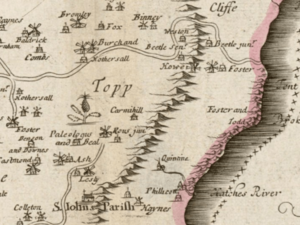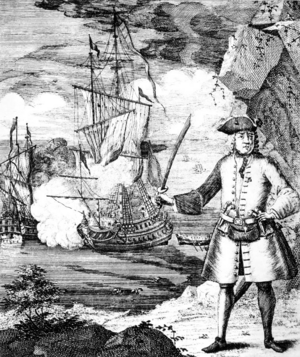Theodorious Paleologus facts for kids
Quick facts for kids
Theodore Paleologus
|
|
|---|---|
| Born | c. 1660 Barbados |
| Died | 1693 (aged c. 33) At sea, near A Coruña, Spain |
| Buried | A Coruña, Spain |
| Noble family | Paleologus |
| Spouse(s) | Martha Bradbury |
| Issue | A son, dead before 1693 Godscall Paleologue |
| Father | Ferdinand Paleologus |
| Mother | Rebecca Pomfrett |
| Occupation | Privateer |
Theodore Paleologus (Italian: Teodoro Paleologo; born around 1660, died 1693) was a sailor and a privateer. He is sometimes called Theodore III by historians to tell him apart from his grandfather and uncle, who had the same name. Theodore was the only known son of Ferdinand Paleologus. His family believed they were descendants of the Palaiologos dynasty, who were the emperors of the Byzantine Empire from 1259 until it fell in 1453. This would make Theodore possibly the last male member of that ancient royal family.
Theodore worked as a sailor on a ship called the Charles II, which was led by Captain Charles Gibson. A year after Theodore passed away, the ship's first mate, Henry Every, took control of the ship and became a very famous pirate. Theodore lived in Stepney, London, with his wife, Martha Bradbury, who was from Barbados. He died in 1693 at sea and was buried in A Coruña, Spain. Martha was expecting a baby when he died. Their daughter, Godscall Paleologue, was born after his death. She was the last known person in their family line.
Theodore's Life Story

Theodore Paleologus was born around 1660. He was the only child of Ferdinand Paleologus and Rebecca Pomfrett. Rebecca's father owned land in Barbados. Theodore was named after his grandfather, which was a common Greek tradition. As Ferdinand's son, Theodore might have been one of the last living family members of the Palaiologos dynasty. This family ruled the Byzantine Empire for many years, from 1259 to 1453. Most people at the time believed his family was truly descended from these emperors.
The first time we hear about Theodore is in his father Ferdinand's will, which was written on September 26, 1670. In the will, his name was spelled "Theodorious." Ferdinand left half of his property and money to Theodore. This money was meant to help with Theodore's "maintenance and education" until he turned fourteen.
After Ferdinand died in October 1670, Theodore's mother, Rebecca, married again. Her new husband was probably Captain Alexander Beale. In 1679, records show that Alexander Beale owned a lot of land and many enslaved people. A map from 1685 shows a farm near St John's church called the "Paleologus and Beal" plantation. This means that Ferdinand's old farm was split between Theodore and his mother. Theodore became a business partner with Alexander Beale. The map shows a pineapple on the farm, which suggests they grew pineapples along with sugar. Rebecca and Alexander Beale had more children, who were Theodore's half-siblings. Rebecca stayed involved in business and local politics in Barbados. Her new husband also took on many of Ferdinand's old roles, like becoming a churchwarden.
On October 14, 1684, Theodore married Martha Bradbury in St Michael's Church in Bridgetown. Martha was the daughter of Christopher Bradbury. Eventually, Theodore and Martha left Barbados and moved to Stepney in London. Theodore worked as a sailor on a ship called the Charles II.
On August 1, 1693, Theodore wrote his will while he was at sea. He named his wife, Martha, as the person who would manage his affairs after his death. The ship's captain, Charles Gibson, and three other people witnessed the will. Theodore died at sea that same year, near the coast of Spain. He was buried in A Coruña, Spain, soon after. His grave's exact spot in A Coruña is not known, but it might be in the "English Cemetery."

Some people used to think Theodore served in the Royal Navy, which is the British navy. However, there are no records of him or his ship in their files. It's more likely that he was a privateer. A privateer was a private ship or person who was allowed by a government to attack and capture enemy ships during wartime. This was a bit like being a legal pirate. Theodore's ship, the Charles II, was a strong warship that worked for Spain. The first mate on the Charles II when Theodore was aboard was Henry Every. Just one year after Theodore died, Henry Every led a rebellion on the ship. He took control, renamed it the Fancy, and became a very famous pirate.
Theodore and Martha had a daughter who was born after his death, on January 12, 1694. Her name was Godscall Paleologue. We don't know much about Godscall, but she was the last known person in the Paleologus family. Theodore also had a son who was born in Stepney, but this son likely died before Theodore, as his will only mentioned his wife. Theodore was the last known male member of his family.
Theodore in Books
Theodore is an important character in some novels by a British author named Jane Stevenson.
In her book The Pretender (2002), Theodore is called Lieutenant Theodore Paleologue. He is the son of "Sir Ferdinando" and lives in England during the time of the Restoration (when the monarchy was brought back). In the book, Theodore is a brave officer in the Royal Navy, not a privateer. He is described as having a short, pointy beard and a hooked nose. In one scene, he tells people that he should be "emperor of the world." In this story, his parents are shown as kind slave owners, and Theodore marries a native Kalina woman, not the real Martha Bradbury.
In Stevenson's book Empress of the Last Days (2003), which is set in modern times, the main character falls in love with a young Barbadian girl named Melita Paleologue. They trace her family history back to a marriage between a daughter of King James VI & I, Elizabeth Stuart, and a dark-skinned doctor. In this novel, Theodore dies as a hero in a battle at A Coruña. His daughter, Godscall, marries a son of the Winter Queen (Elizabeth Stuart). The book also includes a historical event where people from Greece came to Cornwall in the 1800s looking for descendants of the old imperial family. In the novel, they don't believe the proof given by Godscall's descendants because of their skin color.

